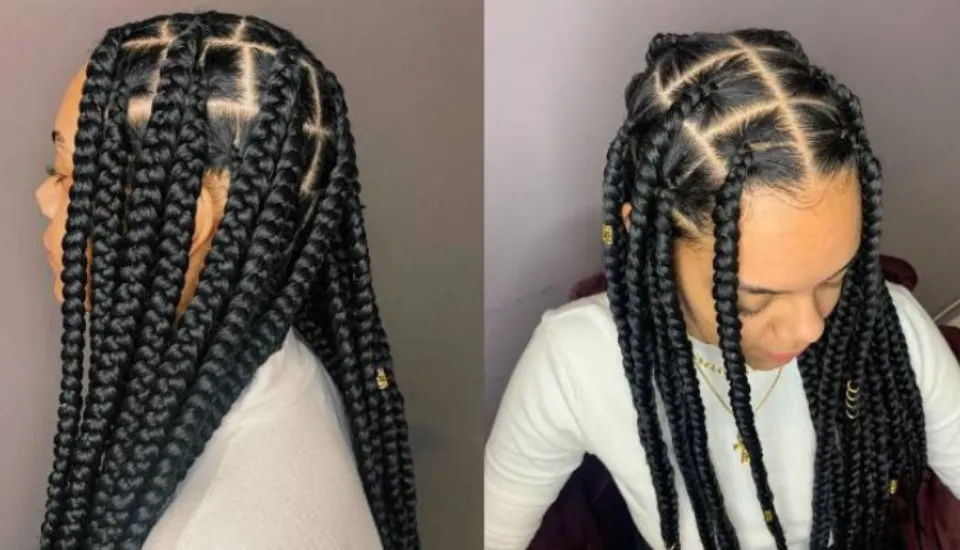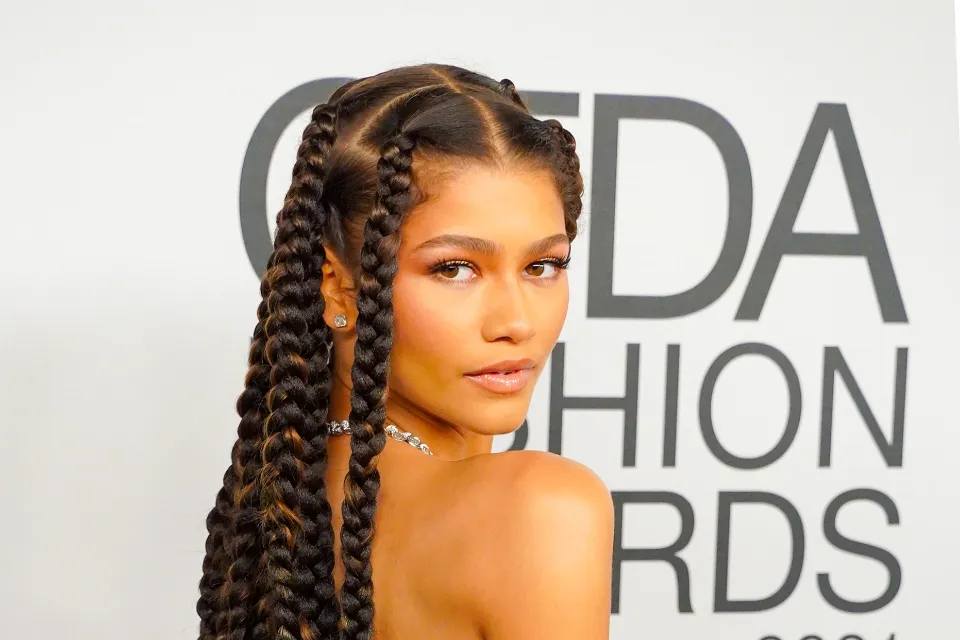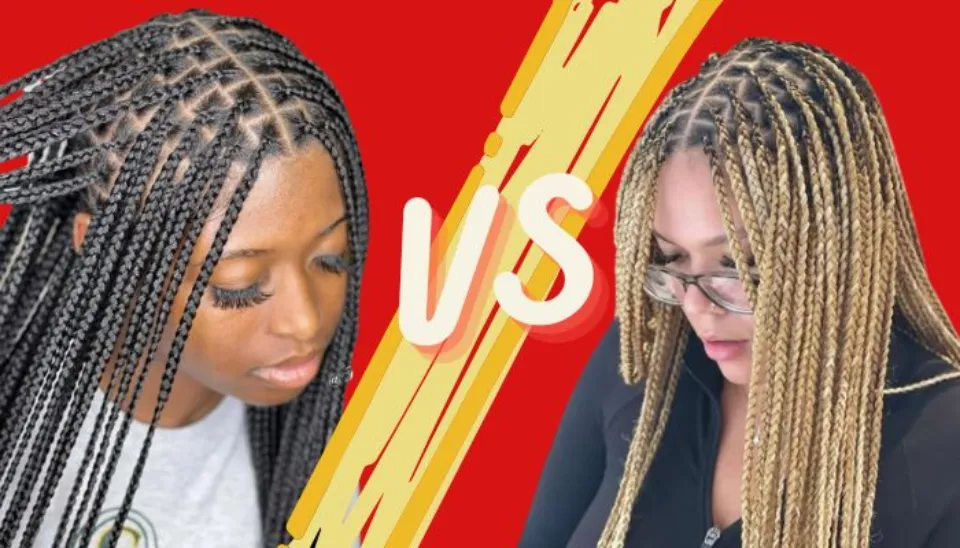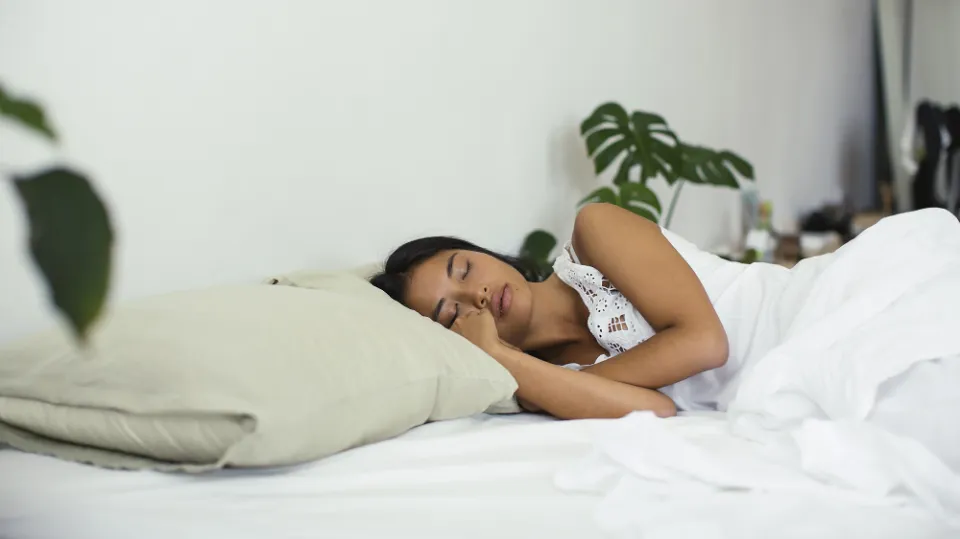Choosing between knotless braids vs box braids can be a daunting task. Don’t worry; this guide will assist you.
While box braids and knotless braids are similar, knotless braids use a different feed-in method that requires less tension and is kinder to the scalp. The end result is a lightweight, pain-free braid with all the elegance and adaptability of more conventional box braids.
Let’s dive into what’s the difference between knotless braids and box braids and which one should you choose.
What’s the Difference Between Knotless Braids Vs Box Braids?
Unlike conventional box braids, which begin with a knot at the base of the hair where synthetic hair is added, knotless braids do not. The synthetic hair is instead gradually added to the braid itself using a special feed-in technique.
As a result, the braid is softer on the scalp than a box braid and lies flatter. It is also more flexible.
Installation
Knotless braids take longer to install than traditional box braids, but with both styles, the smaller the braid, the longer it will take to install. Depending on the braid size and the braider’s experience, some braids, such as micro braids, can take up to 12 hours and require multiple visits. Other braids, however, can be completed in nine hours or less.
Knotless braids take longer to complete because they require a more complex technique and are a more recent hairstyle with fewer braiders who are familiar with it. They might still be learning the method, so this indicates.
Duration

By nature of their installation technique, knotless braids can last as long if not longer than box braids. The feed-in method used in knotless braids enables new growth to expand naturally and extends the amount of time this style can be worn. However, new growth can also make your braids heavier. Knotless braids should still be removed after four to six weeks to give your hair and scalp a break.
The duration of your braids will also depend on your stylist’s technique, how well you take care of the braids with techniques like deep conditioning and proper washing, as well as how long you leave the braids in place. In general, smaller braids will last longer than larger ones for both styles. Micro box braids can last up to 12 weeks.
Read More: Do Knotless Braids Hurt?
Styling
These fashions are well-liked because they are versatile and low-maintenance while still keeping you looking stylish. However, with box braids, the knot lifts the hair off your scalp due to the technique used. Consider knotless braids if you prefer your hair to sit flatter against your scalp.
Knotless braids lack that knot, and also have more flexibility, meaning you don’t have to worry about letting your hair loosen up for nearly as long after an appointment.
Whether you prefer updos or wearing them down, both looks offer a variety of styling options.
Scalp Sensitivity
Your scalp’s sensitivity should be taken into account when choosing a style. Box braids are much tighter and can cause pain, especially for those with sensitive scalps. While braids themselves help strengthen hair, the process of installing box braids can lead to hair loss or breakage in extreme cases.
Consider knotless braids rather than traditional box braids if you’ve previously had painful hair appointments.
Whatever you decide, make sure to let your hairstylist know if you’re in any pain.
Cost
Knotless braids typically cost between $160 and $600, while box braids cost typically ranges from $75 to $450. These prices don’t include the cost of any synthetic hair you’ll be using.
The price to have box braids or knotless braids installed by a braider varies depending on a number of variables, such as the size of the braid, the complexity of the style you want, your location, and the braider’s experience. Generally speaking, the cost of installing braids increases with braid size.
Knotless braids cost a little more than standard box braids for a few reasons. They are primarily a well-liked style that is harder to master for braiders.
That means braiders who book these appointments are more in demand. Additionally, they require more time to install, costing you more time from your braider.
Pros and Cons of Knotless Braids

Knotless braids may be the better choice for you. Discover the benefits and drawbacks of this fashion by reading on.
Pros
- You get natural results from them. Since knotless braids involve braiding your natural hair first, there’s no knot at the root. So, you can expect your knotless braids to look like your own hair unlike box braids. Who wouldn’t want their hair to appear more organic?
- Knotless box braids don’t cause any pain because the extension hair isn’t inserted too close to the scalp, which means that they are almost completely free of scalp tension. That means you won’t need pain relievers after you get your braids done. Alternatively, if you’d prefer, you can pull your braids up into a ponytail right away.
- Typically, they weigh less. It won’t feel as heavy as other braided protective styles because the extension hair is added sparingly along the braid’s length rather than all at the root. Your risk of experiencing neck pain or traction alopecia after installation is decreased as a result.
Cons
- They don’t endure for very long. On average, you can expect your knotless braids to last up to 6 weeks, which is two weeks less than traditional box braids. Because there isn’t much extension hair at the roots of the braids, the hair frizzes more quickly and they don’t last as long. Your hair texture, the amount of tension used during braiding, whether you sleep with a silk scarf over your head, and other factors will all affect how long your knotless box braids will last.
- They may be pricey. Knotless box braids take longer to complete than conventional box braids because additional hair must be added down the length of the braid. And this time is usually factored into the price you’ll pay for installation. You should budget anywhere between $200 and $600 for your braids. The price will vary according to the length of your braids, the size of your head, the stylist’s demand, and the braid size you prefer. The cost of the extension hair must also be taken into account.
- Most protective styles are do-it-yourself-able, but this one is a little trickier to master. If you’re not a braider, it can be very frustrating to have to add numerous lengths of extension hair to your braids. This is not to say that you won’t master the technique with time and effort, but it will probably take a lot of both.
- Finding someone to braid your hair without knots might be difficult. There aren’t many stylists who do knotless braids because they’re still a relatively new technique. Finding a professional to do conventional box braids will be much simpler. This is not to say that you won’t find someone, but it could be challenging to do so.
Making the choice between traditional and knotless should be a little bit easier after weighing these advantages and disadvantages.
If you want to learn more, please read our guide on What Are Knotless Braids.
Pros and Cons of Box Braids
You should be aware of the pros and cons of box braids; we’ll go over them in more detail below. Knowing these pros and cons will enable you to decide whether box braids are the right style for you:
Pros
- They endure a very long time. Box braids last from one to two months with proper maintenance. However, how well you take care of your braids will determine how long they last. It will make them last longer if you cover them at night and keep your hands off your head.
- It’s safe for your hair. Your natural hair is largely hidden by the extension hair. Since you won’t be using heat or otherwise modifying your natural hair, this protection (also known as protective hairstyles) can result in increased length retention. The less manipulation your hair is put through, the less breakage you’ll experience.
- It is simple to locate a stylist to install them. It’s not difficult to find someone who can install box braids for you because they’ve been around for so long.
- They are conducive to DIY. Although getting someone else to do your box braids for you can save you some time and effort, it’s not necessary. It’s simple to learn how to do these things on your own by watching a few YouTube videos.
Cons
- They may cause discomfort and make the scalp more sensitive. Holding the natural hair taut is necessary in order to install the extension hair and ensure that it is anchored at the roots. It’s for this reason that box braids are often associated with scalp sensitivity and pain. Some people experience pain levels that require them to take Tylenol or Ibuprofen for a few days following installation.
- There’s a chance that your edges will break. Traditional box braids and neatness go hand in hand, which encourages many people to braid them too tightly. Additionally, there is a chance that your hair may be pulled out whenever it is pulled too tightly. Redness and bumps on your scalp are indicators of impending breakage.
- The knots at the bottom of each section may be offensive to those who don’t appreciate that style of aesthetic.
How to Do Knotless Braids?
Doing knotless braids at home is a great way to save money. You will just have to spend it on locs to make your braids longer. You must now get your hair ready for braiding before you can proceed.
- Before you begin any braid on your hair, you have to make sure it is well-washed and properly cleaned. Nothing from your previous hair care routine, including your shampoo, should be left behind.
- Your scalp needs moisture. Because it could dry out and become itchy, moisturizing your scalp is a crucial step. Poor scalp health affects hair quality. The best oils and oil sprays must be used to properly hydrate your scalp.
- Keep your packs of fake hair nearby because you will need to use them. You can buy the freetress water wave hair pack. Depending on the length, you may require at least 3 packs. additional for longer braids.
- To make the neatest braids, you must have your mousse, hair gel, oils, sprays, and Shine N Jam close at hand.
Now that you have prepared your hair, Read the steps below to get the best looking knotless braids on your own:
Step 1: Depending on how thick or thin you want your braid to be, divide your hair into several sections.
Step 2: Start braiding the little sections after creating a perfect section with Shine N Jam. Once you have braided it twice, you add the fake hair from here on, and you braid everything down.
Step 3: Repeat the braiding for all the sections, and voila! You’ve got your braids without knots.
Although the knotless braid is not particularly difficult to make, it is a time-consuming process, so you should take your time.
With this hairstyle, not only will your hair look much better, but it will also be protected.
Since these braids have no knots, you can wear them in a ponytail or any other style without harming your scalp.
Related Reading:
How to Do Box Braids?

If you want to know how to do box braids on your own, you have to read the simple steps mentioned below.
You must first prepare your hair before beginning to braid it. The same preparation procedures for box braids as for knotless braids are applicable.
Once you are done preparing your hair, you can now follow these simple steps to box braid your hair:
You will need a pack of pre-stretched hair, numerous rubber bands, a comb, and patience because the box braids take some time to complete. Follow the simple steps below to do box braids on your own:
Step 1: Start by creating several sections in your hair.
Step 2: Section off your hair that has been parted using elastic bands.
Step 3: Take the hair from the pack and divide it into the same number of sections as your hair is divided into.
Step 4: Start braiding your hair by wrapping that hair tightly around your hair roots in the shape of a knot.
Step 5: Repeat the same action for all partitions until you are done with braiding all your hair.
You can very quickly box braid your hair by following the above-mentioned simple steps.
Also Read: Can You Swim With Box Braids?
Should You Get Knotless Braids Or Traditional Box Braids?
Here is a guide to assist you in making your decision if you’re still undecided about which style of box braids to choose. Check out the tips below:
- Choose knotless braids if you have experienced breakage or pain with traditional box braids.
- Pick traditional box braids if style longevity is your number one priority. Generally speaking, they outlast knotless box braids by a few weeks.
- Try knotless braids if, above all else, you want your braids to look like they were done with your natural hair.
- Consider traditional box braids if you are new to doing your own hair and want a style that’s easy to DIY.
Final Thoughts: Knotless Braids Vs Box Braids
You now know everything you need to know about box braids and knotless braids.
For the longest time, box braids have been very popular but recently, more people prefer knotless braids.
Even though knotless braids have their own disadvantages, the perks definitely outweigh them. You should definitely give the knotless braid installation a try and see how it improves your appearance if you haven’t already.
Read More: What Are Peekaboo Knotless Braids?
FAQs
How Long Do Knotless Braids Last?
Knotless braids for natural hair can last up to three months, but how long your knotless braids will last depends on a few things: your hair texture and hair porosity, how you take care of them, and how large the braids are.
Do Knotless Braids Last Longer Than Box Braids?
By nature of their installation technique, knotless braids can last as long if not longer than box braids.
Do Knotless Braids Hurt Less Than Box Braids?
Hands down, the biggest relief is the pain-free aspect of knotless braids.




